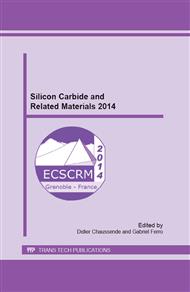p.636
p.640
p.644
p.648
p.652
p.656
p.660
p.667
p.673
The Impact of Interface Charge on the Breakdown Voltage of Terminated 4H-SiC Power Devices
Abstract:
A novel method for analyzing a decrease in breakdown voltage (VBD) in the termination of 4H-SiC power devices after reverse-bias stressing on the basis of change in depletion-layer capacitance is proposed. Test PN diodes terminated with a junction-termination extension (JTE) were fabricated on n-type 4H-SiC and analyzed by I-V and C-V measurements. According to the results of the measurements, VBD after stressing decreases, and the capacitance of the test devices decreases after stressing. Measurements with different chip sizes but the same termination width show that the capacitance decrease occurs in the termination area. The simulated capacitance change, on the supposition that positive charge accumulated at the SiO2/SiC interface, and the measured capacitance change show the same tendency. These results indicate that the origin of VBD decrease is positive charge accumulated at the SiO2/SiC interface of the termination after reverse-bias stressing.
Info:
Periodical:
Pages:
652-655
Citation:
Online since:
June 2015
Keywords:
Price:
Сopyright:
© 2015 Trans Tech Publications Ltd. All Rights Reserved
Share:
Citation:


